an email newsletter released every month highlighting the latest articles, events, technical inquires, and voices from the community
Low SWaP Laser Designators for Mini-UAVs and Handheld Targeting Systems

Posted on March 30, 2020 | Completed on March 26, 2020 | By: Abraham Isser
Are there any low size, weight, and power (SWaP) LDs available for military use in mini-UAS and/or handheld targeting systems?
The Defense Systems Information Analysis Center (DSIAC) was asked to identify if there are any low size, weight, and power laser designators available for use in miniature unmanned aerial vehicles or handheld targets. DSIAC reached out to subject matter experts with QinetiQ to field the inquiry. A report was created, and the requested information was delivered to the inquirer. This report stemmed from a DSIAC-hosted webinar.
1.0 Introduction
Defense Systems Information Analysis Center (DSIAC) staff reached out to subject matter experts at QinetiQ to provide a response to the inquiry.
Laser designators (LDs) have served as a fundamental means of targeting for multiple generations of combat aircraft. With advancements in high-efficiency, diode-pumped laser technology, pulse length control, efficient thermal design, and unique beam stability techniques, laser designators that can fit into mini-unmanned aerial vehicles (UAVs) or handheld targeting binoculars are becoming a reality. Very lightweight/low-power LDs can execute tactical target designation missions at ranges up to 1 km from mini-UAVs and quadcopters or as part of handheld, soldier-borne targeting systems. They stand to add significant capability to ground forces engaged in short-range tactical missions, enabling effective target marking for laser-guided munitions (LGMs). An understanding of key laser performance parameters will promote the development of effective miniaturized LD systems. For purposes of our discussion, low-power laser designators typically range from 10 to 30 mJ, but even 50-mJ lasers can fall into this class.
2.0 LD Characteristics and Considerations
Military-grade LDs emit pulse trains at a 1064-nm wavelength, not visible to the human eye. They must comply with the North Atlantic Treaty Organization (NATO) Standardization Agreement (STANAG) 3733 standard for pulse codes. The standard defines specific pulse repetition frequency (PRF) structures of emitted pulses that must be compatible with LGM missile seekers detection electronics. As seen in Table 1, output energy, beam divergence, and beam jitter are key contributing parameters to effective target designation. High output energy, narrow beam divergence, and low beam jitter increase overall designation range. LD range varies with atmospheric transmission and visibility conditions. For example, poor visibility conditions can reduce designation range due to high absorption of laser energy in the atmospheric path. Most LDs generate significant heat during target designation, limiting the operational duty cycle to ~25% to enable heat dissipation (e.g., laser on for 1 minute followed by laser off for 4 minutes). The power that an LD can output is scaled to the size, weight, and power (SWaP) allocated to the system. A low-power, 10–30-mJ LD weighs about 100 g, where a 50-mJ LD could weigh 500 g or more. Since limited SWaP is available on mini-UAV payloads and handheld targeting systems, LD power is limited. However, 10–30 mJ power is enough to designate most tactical targets at a 1-km range, as shown in Table 1 [1].
Table 1: Key Performance Parameters
| Parameter | LD Performance |
| Wavelength | 1064 nm |
| Output Energy | 10–30 mJ |
| Beam Divergence | 500–1000 µrad |
| Pulse Width (FWHM) | 20 ns |
| Pulse PRF Code | Bands I and II defined by NATO STANAG 3733 |
| Pulse-to-Pulse Stability | 4 µs |
| Duty Cycle @ 20 Hz | 1 min continuous/4 min OFF period |
| Beam Jitter | <50–100 µrad (<10 % of beam divergence) |
| Pulse-to-Pulse Energy Stability | <10% in any 100 pulses
<10% consecutive pulses |
Pulse energy should be stable over temperature to provide sufficient energy for standoff designation range and enable uninterrupted munition guidance. It should also be stable under all STANAG 3733 PRF codes to enable secure and uninterrupted designation. Figure 1 shows pulse energy and pump time performance over temperature for a 50-mJ laser designator operating at 10- and 20-Hz PRF. While there are some variations, the laser provides consistent >50 mJ of output power and >100 µs pump time over the entire temperature range [1].
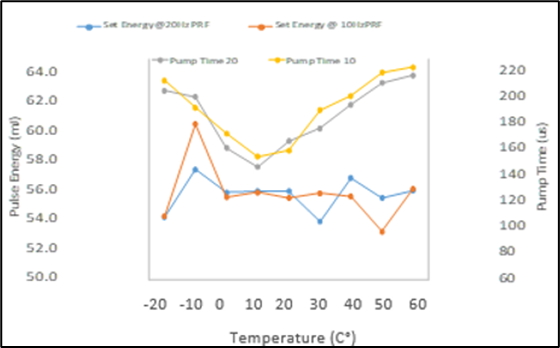
Figure 1: Pulse Energy and Pump Time Over Temperature for a 50-mJ Laser [1].
Another important parameter required for adequate designation is pulse width. As seen in Figure 2, laser designators should have a pulse width of 10–25 ns for effective target designation, compliant with the NATO STANAG 3733 standard [1]. Pulse temporal width is an important parameter because it determines the amount of energy emitted from the LD. Pulse width is typically between 10 and 25 ns and has a direct impact on LD range performance. A narrow pulse will not carry enough energy, while a wide pulse will not be compatible with missile seekers’ detection electronics.
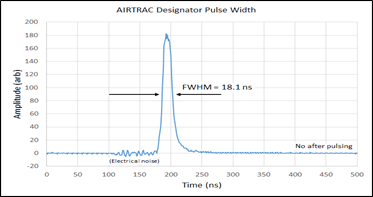
Figure 2: Laser Pulse Width [1].
The beam parameter product (BPP), which is a product of laser beam waist and laser beam angle, quantifies the quality of the beam and how well it can focus. The beam angle, combined with beam jitter and stabilization system residual jitter, will define the laser’s total beam divergence. A wide angle of total beam divergence (determined by the “beam waist”) will spill over energy outside the target, reducing the amount of energy reflected from the target back to the missile seeker.
Table 2 provides round trip range performance estimations using the EDR95 model for a standard 10–30-mJ laser. A total beam divergence angle of 500 µrad with residual motion of 100 µrad will enable designation of a 2.3-m NATO target from 2.9-km under clear day conditions. A 1000-µrad divergence and 100-µrad residual motion will enable designation from 1.9 km.
Table 2: Laser Beam Divergence, Residual Motion, and Target Size Estimates
| Total Beam Divergence (µrad) | Residual Motion (µrad) | Target Size (m) | EDR95 (km) |
| 200 | 0 | 2.3 | 11.9 |
| 200 | 20 | 2.3 | 9.7 |
| 200 | 40 | 2.3 | 7.3 |
| 200 | 60 | 2.3 | 5.8 |
| 200 | 80 | 2.3 | 4.7 |
| 200 | 100 | 2.3 | 4.0 |
| 500 | 0 | 2.3 | 4.8 |
| 500 | 20 | 2.3 | 4.6 |
| 500 | 40 | 2.3 | 4.1 |
| 500 | 60 | 2.3 | 3.7 |
| 500 | 80 | 2.3 | 3.3 |
| 500 | 100 | 2.3 | 2.9 |
| 1000 | 0 | 2.3 | 2.4 |
| 1000 | 20 | 2.3 | 2.4 |
| 1000 | 40 | 2.3 | 2.3 |
| 1000 | 60 | 2.3 | 2.2 |
| 1000 | 80 | 2.3 | 2.1 |
| 1000 | 100 | 2.3 | 1.9 |
Laser BPP and pulse width performance over temperature for a 50-mJ designator is shown in Figure 3. A laser operating at 0 °C ambient temperature, with a beam waist of 20 mm and BPP = 2, will have a beam divergence of 200 µrad. At –20 °C, the BPP will exceed 4, more than doubling the divergence and significantly decreasing the designation range due to laser spillover and reduction in reflected laser energy.
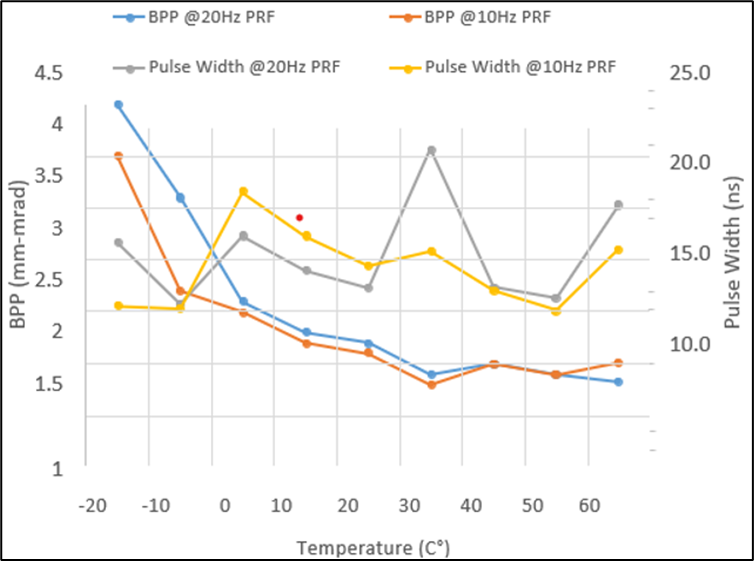
Figure 3: Laser Pulse Width and BPP Performance Over Temperature for a 50-mJ Designator.
In order to provide reliable laser designation throughout missile flight, the missile seeker’s detector requires a signal-to-noise ratio (SNR) of at least 7:1. Figure 4 provides a range performance estimation for a typical 50-mJ laser designator operating at a lock on before launch (LOBL) mode in which the weapon operator receives an indication of sufficient laser power to lock the LGM on a safe trajectory toward the target prior to missile launch. A lock on after launch mode can also be used with similar SNR.
In the figure, the gray curve indicates a condition of self-designation, where the laser transmitter Tx range to the target (R1) equals to the missile seeker receiver Rx range to the target (R2). A 10–30-mJ LD designating from 1 km (Tx) will enable LOBL from more than 6000 m [1].
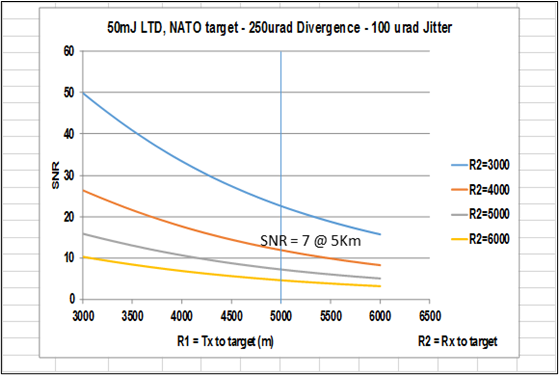
Figure 4: A 50-mJ Laser Designator Predicted to Provide a Reliable LOBL (SNR >7) From a 5000-m Range.
A handheld LD or LD-equipped payload for a mini-UAV could enable target designation at close range to provide longer standoff ranges for LGM-carrying platforms (e.g., Apache helicopter or Reaper UAV). For example, a 10–30-mJ LD onboard a mini-UAV designating a target at 1 km will enable a LOBL for a Hellfire missile onboard an Apache helicopter at a 6-km standoff range, increasing platform survivability.
3.0 Market Forecast and Competitive Landscape for LDs
The global military LD market is anticipated to reach $3.6B by 2027 and expand at a stable compound annual growth rate (CAGR) of 8% worldwide, including 4.3% in North America and 8.6% in Asia between 2019 and 2027, according to a new research report published by Transparency Market Research titled “Military Laser Designator Market – Global Industry Analysis, Size, Share, Growth, Trends, and Forecast” [4]. Europe’s share is also expected to grow, while many of Europe’s aircraft manufacturers are incorporating military LDs in their designs. Adoption is also increasing by homeland security agencies, while military LDs are increasingly used on unmanned and handheld systems.
Industry will continue to advance low-SWaP lasers to support these trends. Enhancements to power, stability, and beam divergence will be required to achieve accurate aim for precision ground strike. These will play a significant role in the vehicle-mounted segment maintaining market position. Industry will also mitigate risks like indiscriminate firing. LGM manufacturers should consider redesigning current missile seekers compatible with NATO STANAG 3733 to enable detection of continuous wave laser designators. Weather effects, deployment of smoke screens, and hazards associated with laser operations may hamper the growth of the military LD market over the forecast period.
Table 3 lists key features of currently available LDs providing output power >50 mJ but weighing >1 lb. Although most LDs available today provide this output, several companies are developing lower SWaP LDs that can fit into mini payloads, including the Areté Airtrac LD (10–20 mJ and 30–70 mJ) and Elbit System’s micro designator marker LD (10 mJ) [1–3].
Table 3: Available LDs [1-3]
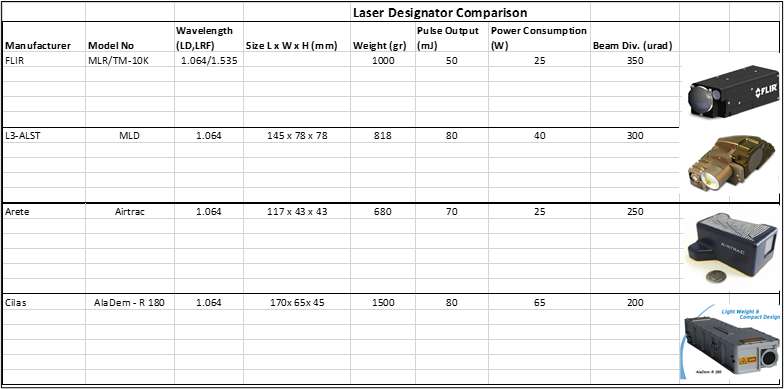
References
[1] Areté Associates. “TID-1572.” http://arete.com/wp-content/uploads/2016/03/TID1572 Brochure-v1.0.pdf, accessed 19 March 2020.
[2] Blinde, L. “Elbit Systems of America to Debut Its Solutions for Real-Time Intelligence and Terrain Dominance.” https://intelligencecommunitynews.com/elbit-systems-of-america-to-debut-its-solutions-for-real-time-intelligence-and-terrain-dominance/, 12 October 2014.
[3] L3Harris. “MLD Miniature Laser Designator.” https://www2.l3t.com/alst/pdfs/datasheets/ L3HARRIS_SpSh_ALST_Mini-LD_Final_Approved.pdf, accessed 19 March 2020.
[4] Transparency Market Research. “Global Military Laser Designator Market Revenue.” https://www.transparencymarketresearch.com/military-laser-designator-market.html, accessed 19 March 2020.
Want to find out more about this topic?
Request a FREE Technical Inquiry!

